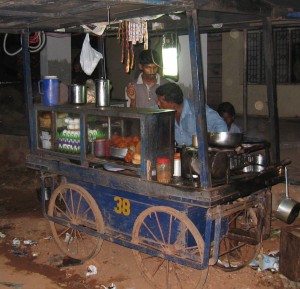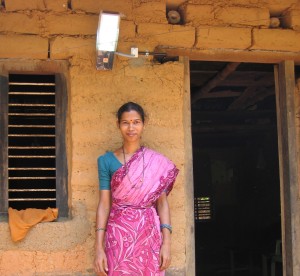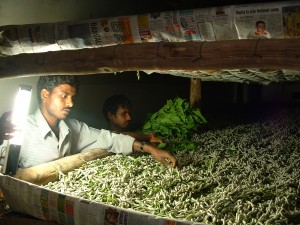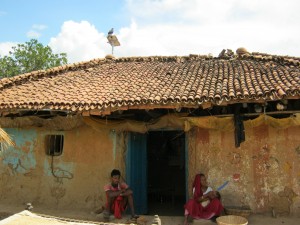Running a business on a social entrepreneurship model is no easy task. It requires a fine balancing act between a profit centred approach and the larger social goals of your enterprise. Last year Forbes India Magazine reported that for the year (ending March 30, 2012) SELCO’s revenue stood at Rs. 17 crore from which it was expected to make a profit of Rs. 1.2 crore. It had by then sold solar lighting to more than 100,000 households, many of them in extremely poor hamlets.
It was this resounding success of SELCO along with their model of decentralised energy solutions for the underserved—the millions of rural poor in India; that motivated me to reach out to Dr Harish Hande, the Magsaysay Award winning founder, for an interview with Fundamatics. But an hour’s telephonic conversation with him convinced me to change track mid-course.
Here was a successful entrepreneur who told me that his personal belief is that he should own no assets in life and shared that he was at a point when his bank balance was so low that the visa authorities questioned his ability to sustain himself for a planned trip to Europe. A business man who does not believe in making money! Having possessions!! And someone who told me that the technician who spends 6 hours daily with a client as opposed to him who now spend 20 hours in a year with a client deserved a greater stake in the organsiation. Not because he is a closet leftist but because he considers it a pragmatic approach of creating financial inclusivity and sustainability for the organisation in a holistic manner.
But what was even more interesting was what he shared about SELCO as it made me realise that this was the more unique narrative and the real story worth featuring. Because the SELCO model is about innovation at many levels, most importantly in inverting existing ideas, thought processes, beliefs and above all power structures and hierarchies. SELCO is not just about a successful model for social entrepreneurship but about empowering the rural poor and turning hitherto employees and service providers into employers and clients. The transformative potential of such a narrative is huge. Harish is thus merely the voice albeit an alternative one—that recounts the SELCO story with no attempt on my part to formulate it into the‘right’ political discourse. The reader is less interested in what I think and can make what they wish from what he shares. I did ask Harish about his personal journey but it was only to put in context the evolution of the concept and practice that is SELCO and how it can be replicated to create the right eco system for an energy revolution in India.
The Evolution of a Solar Evangelist
Harish told me about growing up in the steel town of Rourkela in Odisha where he did all his schooling up to 12thstandard. He followed it with a degree in Energy Engineering from IIT Kharagpur (the first IIT to set up an Energy Engineering department in India long before IIT Bombay). There was an element of chance here as although Harish opted for Energy engineering from the available options based on his JEE rank, his interest revolved more around Mechanical Engineering and thermodynamics.
From the world of theory and Mathematics, Harish discovered a true interest in Energy only from his third year onward but it did start off from an existing interest in solar energy. By the time he applied for a Master’s programme in the US, his interest had further focused to a sustainable energy perspective. His Master’s and PhD were pursued in the US at the University of Massachusetts, Lowell, also in energy engineering with a focus on rural electrification. It is worth pointing out that all of Harish’s education was focused on mastering one discipline and all his training and field work was in one area. Harish pointed out “in 1991 I had the chance to go to the Dominican Republic and there I met quite a few people who were using solar energy and these were poor, impoverished farmers who were decentralised in many ways. This made me look at decentralised energy more deeply. My travels in India and Sri Lanka provided insights not only on decentralised energy but also on the linkages between poverty and sustainable energy”.
What SELCO tries to do is customisation of the technology along with appropriate financial products delivered at the doorstep of the end user with after sales services.
Harish Explains the SELCO Model
In synopsis what SELCO tries to do is to provide a customised solution at the door step of the end user. What we mean by customised solution is that is that it would be customised in terms of the utilisation of the technology or it could be technology in combination with an appropriate financial structure. This is possible as SELCO works with third party banks to finance the end user depending on their cash flow. For instance a paddy farmer will get a loan for 5 years and he will repay on a yearly basis, a peanut or a sugarcane farmer will repay twice a year, a school teacher once a month. A potato vendor will want a yellow light that will subdue the blemishes in her potatoes, whereas a tomato vendor wants white light because tomatoes appear redder in a white light. It is basically customisation of the technology along with appropriate financial products delivered at the doorstep of the end user with after sales services. We have 41 offices in Karnataka alone based on the concept that the area of jurisdiction of a technician for sales and service should be not more than a 2-hour drive on a motorcycle. We work with appropriate banks in that area to provide financial services to the end user. So far all repairs have been done by SELCO technicians and even today 95% of the after sales services are taken care of by SELCO technicians but we have also started working with a lot of technicians who work in repairing TVs, pumps and the likes to train them to become service associates for simple after-sales services. For the more complicated services it is always SELCO representatives.
There is an intensive focus and belief on the human interaction at SELCO, be it between the end user and our technicians or our local branch manager and the bank manager and the end user. A few years ago, over 200 clients attended the wedding of a SELCO technician, which is a testament that highlights how this interaction becomes personal in many ways.
On Scalability and Creating an Eco system for an Energy Revolution
Let us bifurcate SELCO and the concept that underlines it. The concept, to provide door step service using third party finance, is highly scalable and that means the SELCO model needs to be replicated. In fact that is why the SELCO Incubation Centre was created— to inspire the next generation of youngsters to generate more innovative ideas. They do not have to make the same mistakes that we’ve made in the last 19 years. This can be done by focusing on the processes. To learn the processes in a manner that these are considered hard and fast but are malleable so that they can to be changed and modified based on the segment and the area that you come from. For instance, we have helped start one in West Bengal, one in Rajasthan, and now another one in Manipur. They need not take the name of SELCO as we have positioned ourselves as an open source organisation.
Unless and until we can create an eco system where the poor become employers and not employees, we will not see a change. But how do you give 70% of the Indian population who seem to be left out of the growth story, an equal opportunity? We need to provide them with proper tools and equipment that can empower them.
A Street Vendor Model
The only other equivalent model to ours is that of the Street Vendors and here the process of street vending is replicated. A street vendor’s business is customised based on where they are located and to local needs. For example, the vegetable seller near my house will sell a different set of vegetables as compared to the street vendor near your house. But you will never hear of two things. A street vendor going out of business and even if one might fail others won’t. Street vending as a concept is successful and that is the model that we are trying to pushto empower numerous entrepreneurs.
SELCO Incubation Centre started in July 2012. Approximately 50 people have gone through it. In every Incubation cycle approximately 150 people apply. We select about 10 from them who will go through this rigorous process. Currently there are 5 who have graduated out completely and there is another lot of 15 who are in different stages of incubation. Of the five, two have already secured funding another should get funded by December 15th; the others should be ready for investments by June 2014.
On Mistakes that Entrepreneurs Commonly Make
My experience is in the social entrepreneurship space and the most common mistake people make who want to enter the social entrepreneurship space is that they think – “let me first write a proposal, get the money, and then I will start”.
If you create ecosystems where ability and experience are given precedence over received knowledge then things do work differently and hierarchies can be inverted. It happens at SELCO every day.
Money is only one part of the linkage, the more important question is, “ do you have an understanding of what you want to do?” The first funding I raised was only after 3 years. I did not even come out of the rural areas for 3 years. This is because if I wanted to put solar energy in the hands of the end user, I needed to ask myself, “do I know what he feels, what his needs are?” If I want to set up an office, “do I know how the manager who will work in that office feels? Does the technician who will install the systems know what is the expected reaction that he will get from the end user?”
The important question for me was “How well do you know your end user or the eco-system in the rural areas?”
People need to spend more time in knowing their customers and focusing on the processes and for that, you do not need money. To write a business plan for a potential idea that we have not experienced ourselves, where the authenticity of your presentation is based only on how best to present it using power point, is not enough. People now think that if I have an idea and if I put in a PPT, I am an entrepreneur. And then all I have to see is how I will scale up in the next 5 years and earn millions. My question to them is, “Have you felt it? Have you gone through it? Have you actually gone through the rut of it?” That is the challenge, intimately knowing all the parts of what you are trying to achieve. To focus on writing a business plan and then marketing it by going on Twitter and Facebook is the wrong way to approach it. What is required is an investment of time and energy to understand the whole process right from scratch.
I have nothing against people who want to become entrepreneurs for the sole purpose of making money. But it remains a fact that some of the most successful organisations around the world were started with the intention of bringing new ideas forward and building upon them. They clearly didn’t think only in terms of money. And any successful Business be it GE or Reliance for example, all took time to build up. Processes take time and if money comes before your passion then it is a very short term view and an unsustainable way of thinking.
I think social entrepreneurship is for people who can balance their financial ambitions with a social responsibility and environmental sustainability. It is also a process that requires patience because building an organisation involves time and sustained and consistent effort.
On the Importance of Innovation
For us at SELCO, innovation is key but it has various definitions, it could be about how you position yourself as an anthropologist because the intervention of selling energy services is not like selling the same kind of service to everybody. The needs of the end users are different, their financial outputs are different and their market linkages are different. It is about figuring out what part of this ecosystem is missing. Are you for instance, able to first, figure out what the missing link is? Second ask yourself, “what is a sustainable way of plugging that linkage.” and finally, “how do you scale that process up?” This is not about scale from an organisational perspective but scale from a process perspective.
Let me illustrate by an example. When you look to serve very poor communities as clients, where the bank refuses to give them loans, SELCO initially creates a guarantee mechanism for our customers with the Banks and then slowly as the people pay back to the bank we withdraw ourselves from the guarantee mechanism as the people have been transformed to bankable individuals on their own.
Take SELCO’s work with the Siddi community for instance, they earn 1600 rupees a month of which they spend 140 on Kerosene and candles and 40 on mobile charging as they have to take their mobiles somewhere and they spend Rs 5/charge and 8 such charges a month. This 200/month amounts to Rs 12,500 in 5 years but a solar system at 14% with two lights and a mobile charger costs Rs 9,000 in 5 years. It is not Technology; it is not affordability that stops them from moving over. It is the banks refusing them loans. When we asked the banks for this money the first time, they refused saying that these are people who have nothing. When we asked them what they wanted they said that they wanted 100% guarantee. So we gave them 100% guarantee. After 6 months when we asked them how the collections were they said that they were fantastic. We asked them “if you had this information what guarantee would you have taken from us and they said 20%.” So we immediately removed our 80% of the guarantee money out. But the best response was from one of the Siddi end users when we asked if they were happy. Their response was that yes the light is great but as soon as my solar loan is done, I will take a loan for a sewing machine. This means that they had become bankable and the system itself had become more financially inclusive. For us that is more important. The concept is not to keep solar as the centerpiece but sustainable energy becoming a catalyst for a more holistic development for the end user rather than just giving them a light.
Innovation is about Change… in your thinking
Innovation is not just about a product or a process but can have a deeper connotation in terms of challenging fundamental beliefs and inverting hierarchies.There is a degree of insensitivity among our urban population which needs to change. Sensitivity is crucial. I remember going to a well known research company in Bangalore for a talk. The question I was asked there by the Vice President was, since I travel so frequently to rural areas and since I am from an IIT, could I actually have an intellectual discussion with people in the rural areas! In another Company someone proudly proclaimed “my kids also go to rural areas to teach the kids.” My response to them was “have you also thought that the kids in the rural areas can also teach something to your kids?” We have replaced British colonialism with an educated class and another class system in our country and that needs to break. There is an inequality even in our thinking. There is a respect for human labour in the West but here in India there is still no fundamental respect for human labour.
It is perhaps for this reason that at SELCO no resumes are collected when people are hired and a person’s position in the company is decided not by their degree or qualifications but on what a person can do, how they perform and their ability to deliver. Most people at SELCO do not know of my degrees or my IIT background. This is because the system is set up in a way where such things have little or no relevance. I have irritated Vice Chancellors at Universities where I have been invited to speak because I always make sure that the company colleague who drives the car accompanies me to dinner and we sit together. When SELCO employees travel for work everybody stays in the same accommodation and eats the same food. At SELCO such insidious hierarchies are absent and if you see our reporting structures strange things are happening. People often report to people who are much less qualified in terms of degrees that they have. So if you create ecosystems where ability and experience are given precedence over received knowledge then things do work differently and hierarchies can be inverted. It happens at SELCO every day. It can be done by people who set examples and initiate change.
The going is not always easy as resistance often comes from the outside. Once when we had sent a colleague to a client Company the people in the organisation refused to meet him because he was a technician. I called up and asked the chairman to ask, “May I understand why?” I told him that the technician had a greater understanding of his problem and that he would be the one to find a solution. I then asked him if he was more interested in the protocol regarding who should come or was he more interested in solving the problem?
For me the biggest hurdle towards growth and progress in our country is the problem of wrong perceptions. Many of us are trapped into believing that people from certain sections of the society are unequal to us. As long as we have this mentality we cannot achieve our goal of sustainable development.
Post Script:
I don’t know about the readers but for me there was enough food for thought and inspiration in the conversation. Buried in the text and sub text of the conversation there are many a lesson for not just the budding entrepreneurs looking for answers but for the average educated, increasingly disconnected and alienated urban Indian unplugged from the everyday subject of rural experience. More as it sets a challenge for us as modern subjects on the margins of the global capital to produce new ways of thinking about oneself today.
Leadership, be it of a person or from an organisation, is after all not measured in the words that you speak but in the choices you make. SELCO has made choices that focus not just in their own growth but more importantly also in the holistic growth of the clients that they serve. And it is this part of the story that is truly inspirational and unique. My concluding thoughts are that there is something Gandhian about the SELCO model for was it not Gandhi who said “You must be the change you wish to see in the world.” I hope the reader will also agree.





1 comment
A very nice concept. I suggest that this article to be posted to 2 chiefministers-Telangana & Andhra Pradesh.